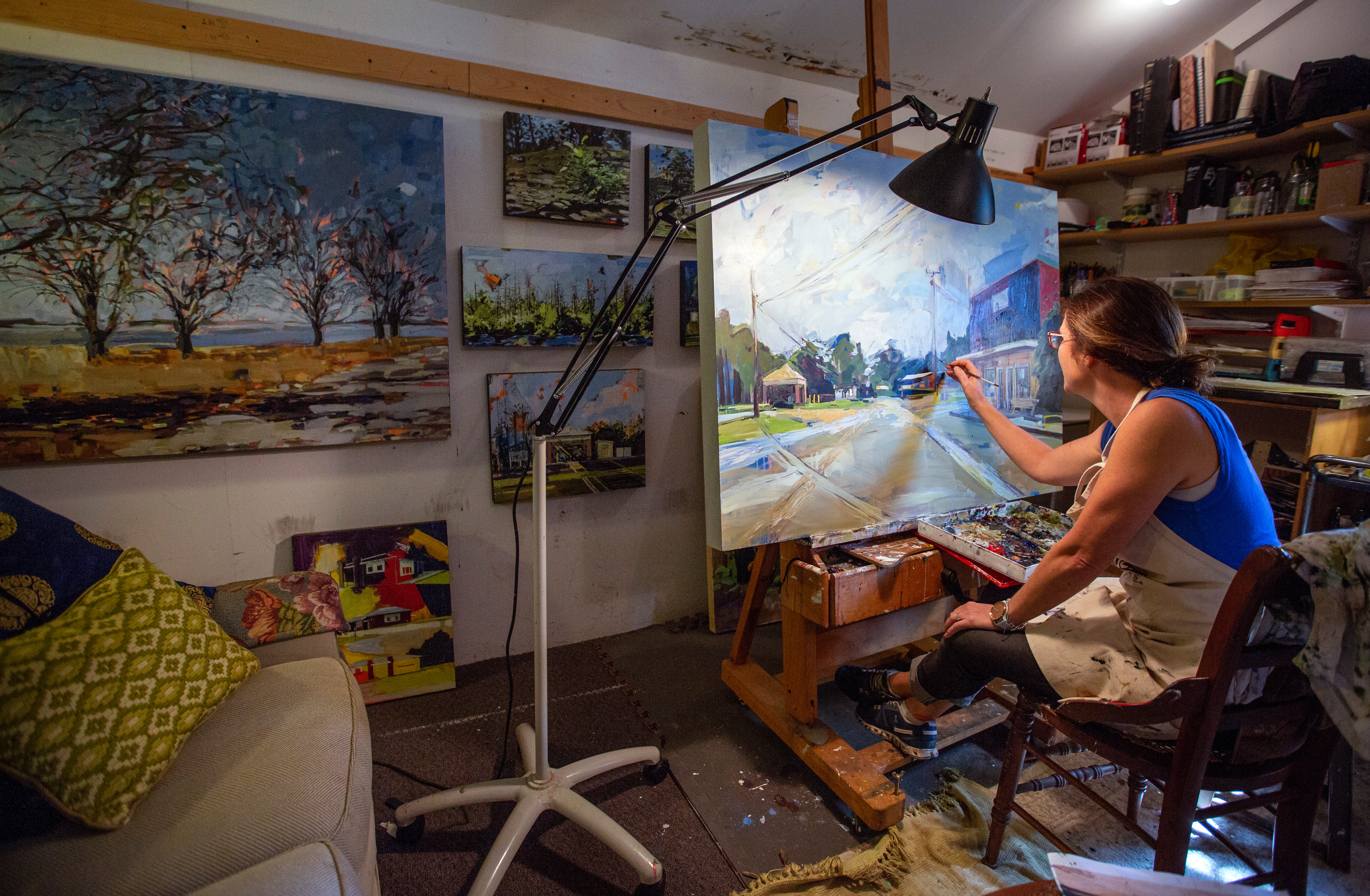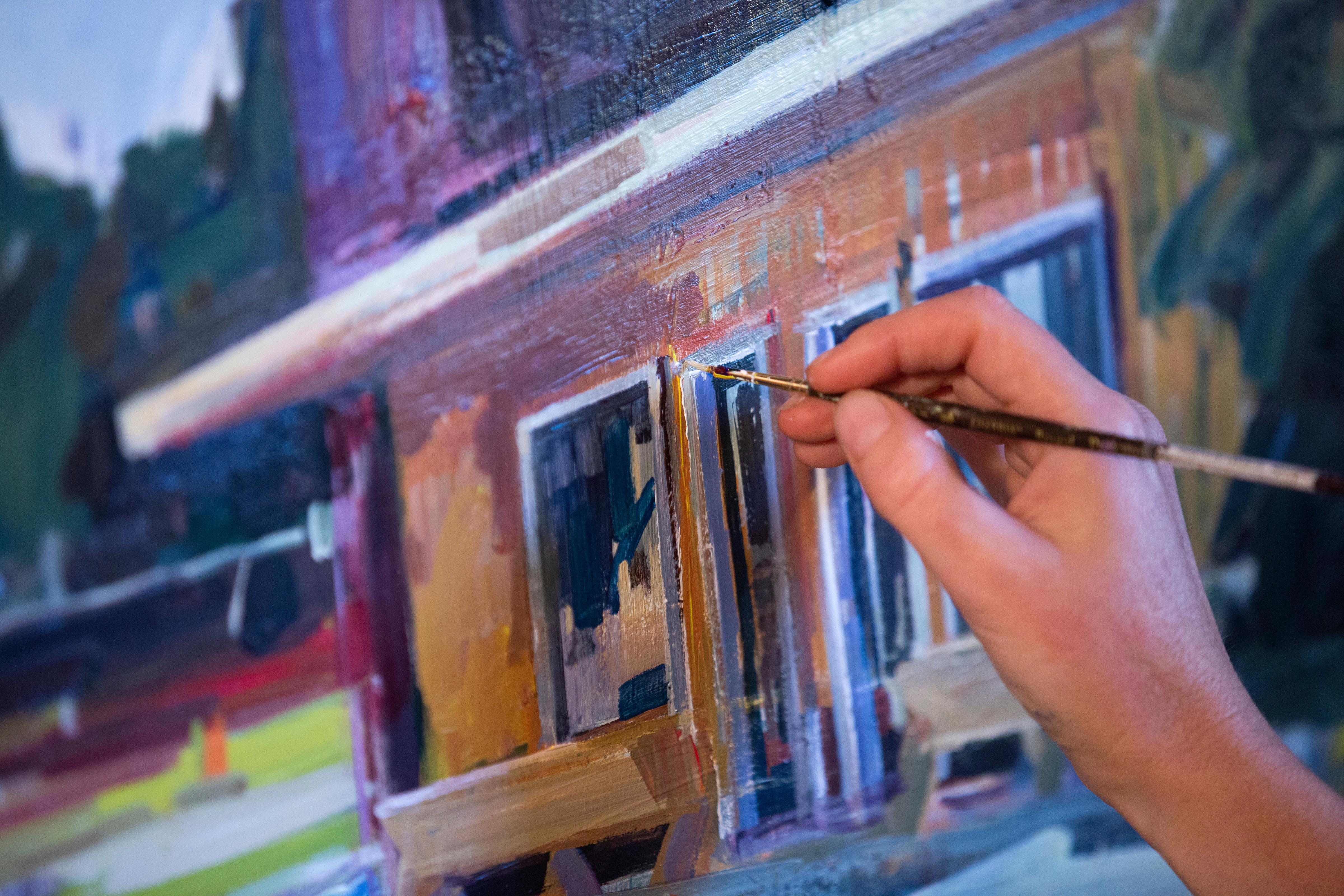
Jennifer Drinkwater paints a Mississippi landscape in her home studio as part of her “What’s Good Project.” She is interviewing people across Iowa and Mississippi about “what’s good” in their communities, and turning those interviews into paintings and drawings. Photo by Christopher Gannon. Larger image.
AMES, Iowa — Jennifer Drinkwater is scouring Iowa and Mississippi for stories about “what’s good” in the world.
These interviews – and the artwork inspired by the interviewees’ words – are the “What’s Good Project,” which documents people’s perspectives on the positives in their communities.
“Culturally, it seems that we are addicted to negativity,” said Drinkwater, Iowa State University assistant professor of art and visual culture and a community arts specialist with ISU Extension and Outreach. “This project recognizes that there’s still people doing good things amidst all the negativity.”
The goal of the “What’s Good Project” is to shine a light on overlooked communities and community assets.
The idea is based on the Community Capitals Framework, developed by Cornelia Flora, distinguished professor emeritus of sociology, and Jan Flora, professor emeritus of sociology at Iowa State. The framework measures seven areas of community vitality: built, cultural, financial, human, natural, political and social.
Drinkwater says she appreciates building her project from this framework because “it’s not Pollyanna.” Much like her other community-focused work, the “What’s Good Project” is an effort to recognize the positives without burying the problems.
“People usually think money and jobs means a community is doing well and if not, people think it’s a dumpster fire,” Drinkwater said. “But this is not about ignoring the challenges, it’s about capitalizing on a community’s strengths and creating a spiraling-up effect.”
Turning stories into artwork
After an interview, Drinkwater transforms the stories into drawings and paintings.

Jennifer Drinkwater paints the details of
a Mississippi landscape in her home
studio as part of her “What’s Good Project.”
Photo by Christopher Gannon. Larger image.
“I’m going into the community and learning from the people there directly what works and creating art based on their words, not mine,” she said.
For many of her interviewees so far, their “good place” has an emotional component. She has found that it’s all about how they feel when they’re in a certain physical space.
This summer she traveled to the Mississippi Delta – where she grew up – to interview people in every county. She wants the “What’s Good Project” to reflect reality: In the case of the Mississippi Delta, that means a blending of cultures, beliefs and lifestyles.
Drinkwater likens the “What’s Good Project” to a visual version of StoryCorps, the National Public Radio program that tells stories of people from all walks of life. Drinkwater’s goal is to one day create an interactive map that users can click through to hear and see people’s stories from around the nation.
So far, Drinkwater has interviewed eight people (four in Mississippi and four in Iowa). She has finished six paintings and six drawings and is in the process of creating more and scheduling more interviews. Once the project is complete, Drinkwater plans to exhibit her work in each county in which she interviewed residents, as well as in Iowa and nationally.
Twenty percent of the proceeds of any artwork sold will go to a community organization designated by the person whose story inspired the piece.
So, what is Drinkwater’s “good place”? She doesn’t have a final answer yet, but she leans toward the Mississippi Delta.
“There’s so much negativity in the world, in addition to my own negativity,” Drinkwater said. “I needed to change my own mindset. Hopefully this can do the same for others.
“Focusing on the negative is easy. It’s low-hanging fruit.”
Drinkwater received grants from the ISU Center for Excellence in the Arts and Humanities and from the Puffin Foundation for this project.
Contacts
Jennifer Drinkwater, Art and Visual Culture, 515-294-5270, jd1@iastate.edu
Chelsea Davis, News Service, 515-294-4778, chelsead@iastate.edu
Quote
“People usually think money and jobs means a community is doing well and if not, people think it’s a dumpster fire. But this is not about ignoring the challenges, it’s about capitalizing on a community’s strengths and creating a spiraling-up effect.”
— Jennifer Drinkwater, assistant professor of art and visual culture, community arts specialist with ISU Extension and Outreach
Follow the ‘What’s Good Project’
On Instagram: @thewhatsgoodproject
On the website: whatsgoodproject.com
Drinkwater's work in Pine Lake State Park for the "20 Artists, 20 Parks" project dovetails into the "What's Good Project."
See it in person
April 4 – May 23, 2020
Octagon Center for the Arts, Ames